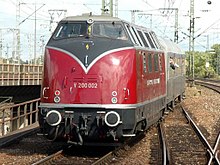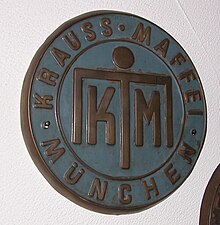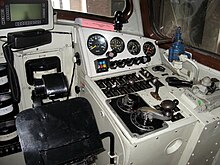DB class V 200.0
| DB class V 200 DB class 220 |
|
|---|---|
|
V 200 033 in the marshalling yard at Fürth (Bayern) Hbf
|
|
| Numbering: | V 200 001-086, from 1968 220 001-086 |
| Number: | 86 |
| Manufacturer: | Krauss-Maffei , MaK |
| Year of construction (s): | 1953; 1956-1957; 1959 |
| Retirement: | 1984 |
| Axis formula : | B'B ' |
| Gauge : | 1435 mm ( standard gauge ) |
| Length over buffers: | 18,470 mm (pre-series), 18,530 mm |
| Height: | 4,160 mm |
| Trunnion Distance: | 11,500 mm |
| Bogie axle base: | 3,200 mm |
| Service mass: | approx. 80 t |
| Wheel set mass : | approx. 20.0 * t |
| Top speed: | 140 km / h |
| Continuous output : | 1618 kW |
| Starting tractive effort: | 235 kN |
| Continuous tensile force: | 177 kN |
| Wheel diameter: | 950 mm |
| Motor type: |
Maybach MD 650 MTU MB 12 V 493 TZ |
| Motor type: | 2 × V12-cylinder diesel |
| Rated speed: | 1,500 rpm |
| Power transmission: | hydraulic |
| Locomotive brake: | single -release air brake with additional brake K-GPR mZ later multi -release air brake with additional brake WS-GPP2R mZ |
The class V 200.0 (from 1968 class 220 , later with the SBB : Am 4/4 ) was one of the first diesel mainline locomotives of the German Federal Railroad (DB). Their striking appearance corresponds to the typical industrial design of the 1950s.
history

The five pre-series locomotives of the V 200 series (V 200 001 - 005) were built by Krauss-Maffei in 1953/1954 , of which the V 200 001 made its first test drive on May 21, 1953 between the manufacturer's plant in Munich-Allach and the approx 71 kilometers away in Ingolstadt and back. The series version (series V 200.0, from 1968 series 220) followed from 1956, with 20 machines from MaK (V 200 006 to 025) and 61 from Krauss-Maffei (V 200 026 to 086) being built, which increased one to 1100 hp Performance of the engines. Visually, they differ from the pre-production series in that they have different (oval) lamps and additional air inlet grilles above the lamps and the changed position of the locomotive whistle.
The original paint of all V 200.0 was purple-red with a black-gray locomotive frame and black-gray contrasting upper window and fan area, drawn down in a V-shape at the front, whereby the "V" shape of the MaK locomotives (flatter) (V 200 006 to 025) extends from markedly different from those of the Krauss-Maffei locomotives (spitzer). The roof had an aluminum-colored protective coating. The locomotives V 200 001 to 055 were given the words "DEUTSCHE BUNDESBAHN" made of large aluminum letters, because they were ordered before the DB emblem was introduced. The V 200 056 to 086 were instead delivered with the DB emblem on the sides and the remaining locomotives were adapted to this appearance during main inspections from the mid-1960s. Under the lettering was a raised nameplate of the manufacturer.
The V 200 carried high-quality express trains on all important main routes . Due to the advancing electrification , however, the machines were pushed out of these services and increasingly used in front of local trains and freight trains.
In operation, the V 200.0 were often overtaxed by increasing tensile loads, so that damage occurred. The German Federal Railroad therefore put the more powerful V 200.1 series (later 221 series) into service from 1962 .
From 1977 the machines were brought together in northern German railway depots. Over time, the increased maintenance required by the two engines compared to single-engine locomotives became noticeable, and steam heating turned out to be disadvantageous compared to electric train heating. The locomotives were gradually taken out of service, the V 200 013 was the last to be taken out of service in 1984. The last operational Bw were Oldenburg and Lübeck. None of the V 200s had been in service for 30 years. Only three locomotives of this series, namely 220 012, 220 023 and 220 060, were repainted in the ocean blue-beige color scheme that was valid from 1974.
Sales abroad
In the 1980s seven V 200s were sold to the Swiss Federal Railways (SBB) ( SBB Am 4/4 18461–18467). They were assigned to several depots and used in front of construction and freight trains. But they were more in the repair than in action and were referred to by disgruntled railroad workers as refurbished scrap, as one could read in the railway specialist literature. The Am 4/4 were scrapped at the end of 1997 and sold to private owners in Germany.
Further locomotives were sold to the Italian Ferrovia Suzzara-Ferrara (FSF) after the decommissioning by the DB . The FSF locomotives were overhauled a few years ago and equipped with modern engines and systems. For the company, which has since been absorbed in Ferrovie Emilia Romagna (FER), they run freight trains in the vicinity of Ferrara - also in double traction .
Whereabouts
Some V 200s are still preserved today.
- The Transport Museum Nuremberg (DB Museum Nuremberg) owns the V 200 007, which was maintained operationally by the association "Historical Railway Vehicles Lübeck" (HEL) in cooperation with the BSW Lübeck. The at the HEL e. V. loaned machine had expired in 2018. Recommissioning is questionable because VM Nürnberg (Stiftung Deutsche Bahn AG), as the owner, has no financial means at its disposal. After the locomotive shed in Lübeck was closed, it has been in the open-air area of the Neumünster railway depot since mid-2019 .
- The V 200 017 is in the Bochum Railway Museum . In the German Technology Museum in Berlin , the V 200018 is.
- The originally also preserved pre-series locomotive V 200 002 of the BSW Nuremberg was destroyed in the large locomotive shed fire at the Nuremberg Transport Museum on October 17, 2005.
- However, the Franconian Museum Railway is in possession of the V 200 001, which is to be refurbished there and made operational again.
- In the Technik-Museum Speyer there are 220 058-2 and 220 071-5, in the Oldtimer Museum Rügen the V 200 009.
- Only V 200 033 of the Hamm museum railway is operational in Germany .
In addition, a driver's cab of the V 200 027 at the MEC 01 Münchberg has been preserved and, after technical modifications, now serves as a control unit for the club system.
At the Westfälische Lokomotiv-Fabrik Hattingen Karl Reuschling (WLH) the spare parts donor is the 220 077 in Hattingen.
V 200 of the Brohl Valley Railway in Unkel , but meanwhile it has the yellow-green Brohl Valley Railway paint
Of the ten V 200s used by the FER in Italy, nine were still operational in 2014. They are only sporadically in service with freight trains. Most locomotives were overhauled in Croatia in 2002-2006 and repowered with Caterpillar engines. They are to be sold.
technology
The V 200 had two high-speed V12 diesel engines with hydraulic power transmission. Both drive groups were independent of each other. Each engine drove one of the two bogies via a torque converter . The top speed was 140 km / h. Two types of engines from Maybach-Motorenbau and Daimler-Benz (Mercedes-Benz) as well as two types of transmissions from Maybach and Voith were used. Engines and transmissions were designed so that they could be freely swapped between the V 200, V 100.10 , V 80 and the diesel multiple unit series VT 08 , VT 11 and VT 12 . In 1959, five locomotives were fitted with MAN L 12 V 18/21 engines on a trial basis. However, these were later replaced by Maybach or Mercedes-Benz engines.
After Maybach was bought up by Daimler-Benz in 1966 and the name was changed to Maybach Mercedes-Benz Motorenbau GmbH (from 1969: MTU Motoren- und Turbinen-Union München GmbH ), the Maybach MD 650 engine used in the V 200 was given the new name MTU 12 V 538 TA 10, the Mercedes-Benz engine MB 820 Bb the designation MTU 12 V 493 TZ 10.
Some locomotives still in operation, especially the machines of the Italian Ferrovie Emilia-Romagna , were equipped with electronically controlled eight-cylinder engines with 810 kW (Caterpillar D3508). In the delivery state, however, the motor control was carried out using an electromechanical speed control.
The switching points of the two transmissions are slightly offset from one another in order to avoid excessive jolts in the train when changing gear. While the Maybach Mekydro transmission K 104 only had one torque converter and four mechanical gears (Mekydro is an artificial word for “mechanical-hydraulic”), the gear change in the three-speed Voith L306 transmission was implemented by switching between three differently dimensioned torque converters.
The converter of the mekydro gearbox is designed as a release converter, which means that the gears are not changed by emptying and filling the converter, but by moving the turbine wheel on its axis. In the disengaged state, brake blading is effective, which brakes the transmission parts to such an extent that the shift claws of the next gear can engage. It was therefore not necessary to drain the converter during normal operation, and the converter was constantly filled with oil. The first series of Mekydro gearboxes therefore lacked the ability to drain the converter. Since a converter emptying is still useful when the engine is idling and certain malfunctions, a Mekydrog transmission with converter emptying was developed during the series delivery of the V 200.
The gearboxes are mounted under the driver's cabs. The starting alternators are located directly above the buffer beams. They are connected to the diesel engine via a through drive of the transmission. The locomotives have only one engine room side aisle between the two driver's cabs. On the opposite side there are some auxiliary companies. The engines are located directly behind the driver's cabs. After the locomotive staff complained about their noise level, the sound insulation was improved during visits to the repair shop. The steam boiler for train heating is in the middle of the locomotive. The roof has removable hoods for expanding the large equipment.
The boiler serves to preheat the machinery and to supply the train with heating steam. It is a smoke tube boiler with a 12 m 2 heating surface. Instead of putting the boiler into operation, the early series machines also allowed external steam to be blown into the cooling water to preheat it. As this caused the additives added to the cooling water to dilute over time, the direct injection of steam into the cooling water was immediately dispensed with and instead the steam heat was transferred to the cooling water via a newly installed heat exchanger.
A D2 self-regulator is installed as driver's brake valve in the series locomotives, and a Knorr No. 10 in the pre-series . From V 200 056 an additional wheel slide protection regulator is available.
The locomotives had the "multiple control type 1949" (the later conventional push-pull train control KWS, but with a different assignment of the 36 cores in the control cable) and were thus capable of push-pull trains and multiple traction. Technically, up to three locomotives could be controlled together. From the beginning, Indusi I 54 and a Zeit-Weg-Sifa were present as safety equipment . A fire alarm system and the possibility of using the boiler feed water for fire extinguishing also served for safety.
Variants:
- 5 pre-series locomotives (V 200, 220), 1,471 kW (2,000 hp )
- 81 series locomotives (V 200.0, 220), 1,618 kW (2,200 hp)
literature
- Matthias Maier: The class V 200 - the first large diesel locomotive of the German Federal Railroad . Eisenbahn-Kurier, EK-Verlag, Freiburg 2005, ISBN 3-88255-208-5 .
- Gerhard Greß: The V 200 of the DB - photo documents from five decades of operational use . EK-Verlag, Freiburg 2007, ISBN 978-3-88255-366-6 .
- Arno Bretschneider: The V 200.0 series . Eisenbahn-Kurier-Verlag, Freiburg 1981, ISBN 3-88255-220-4 .
- Erich Kasten: V 200, a new, powerful multi-purpose diesel locomotive . In: Expansion , issue 11/1957, pp. 690–697, Paul-Christiani-Verlag, Konstanz 1957.
- Josef Brandt: Class V 200 - DB's flagship horse . Weltbild collector's edition “Stars of the Rails”, EAN 402 6411 131207, 2005.
Web links
- V200 007 at Historic Railway Vehicles Lübeck eV (HEL eV)
- V 200 033 of the Hammer Eisenbahnfreunde ( Memento from November 22, 2007 in the Internet Archive )
- db-loks.de
- Delivery and whereabouts list of the V 200
- Homepage of the Franconian Museum Railway for V 200 001
- V 200 as a model
- Class 220: inventory and whereabouts
Individual evidence
- ^ V200 007 at "Historische Eisenbahnfahrzeuge Lübeck e. V. "
- ↑ v200-001.de of the Franconian Museum Railway e. V. Nuremberg
- ^ V 200 in Hattingen . In: Eisenbahn Magazin . No. 4 , 2017, p. 35 .
- ↑ Railway magazine . No. 9 , 2014, p. 22-23 .










